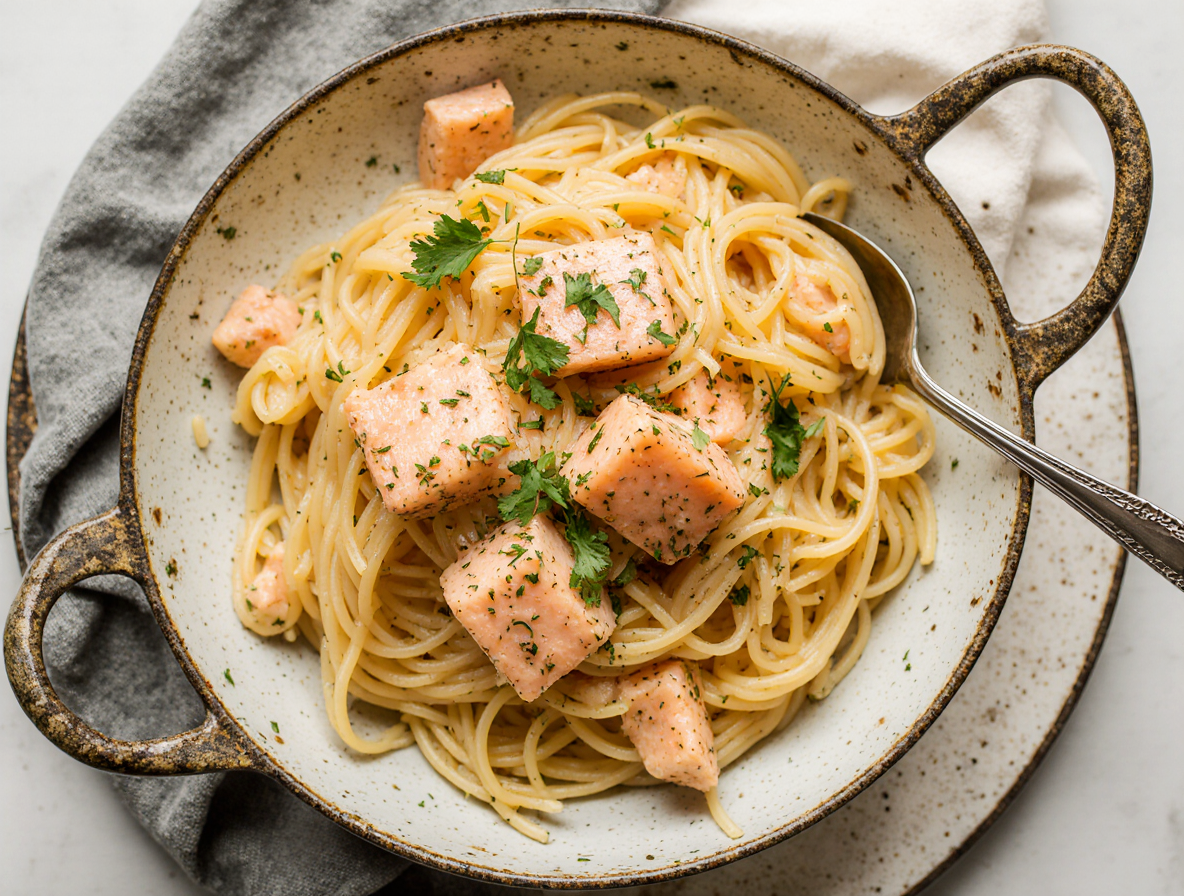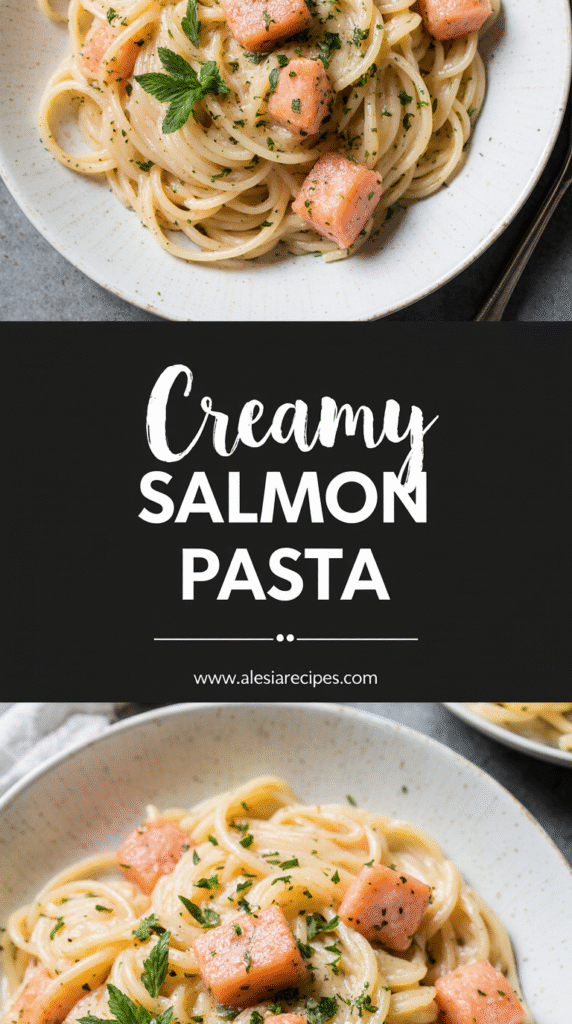How to Make Restaurant-Style Salmon Pasta Recipe: A Foolproof Guide
With over 3.8 million page views since 2018, our salmon pasta recipe has become the most popular dish on Foxes Love Lemons. What makes this creamy salmon pasta so special? It’s that rare combination of elegance and simplicity – a dish that feels fancy but requires almost zero effort.
In fact, this 30-minute salmon pasta with a creamy garlic sauce is quick enough to make any day of the week. The best salmon pasta recipe features perfectly cooked salmon (reaching an internal temperature of 145°F) combined with a heavenly garlic cream sauce. But here’s the thing – despite its restaurant-quality appeal, this salmon cream pasta is surprisingly straightforward to prepare.
Whether you’re planning a romantic date night or just need a delicious weeknight dinner, we’ve got you covered with this foolproof guide. From selecting the perfect ingredients to mastering professional-level garnishing techniques, we’ll walk you through every step to create a creamy salmon pasta recipe that rivals your favorite Italian restaurant.
Choose the Right Ingredients for Creamy Salmon Pasta
Selecting quality ingredients makes all the difference between an ordinary salmon pasta and one that tastes like it came from a high-end restaurant. Let’s break down what you need for the perfect creamy salmon pasta recipe.
Fresh vs. smoked salmon: what works best
The salmon you choose significantly impacts your final dish. Fresh salmon filets (about 3/4 pound for a recipe) give you a flaky, tender result with clean flavor. For fresh salmon, you can either bake it until cooked through or pan-sear it for a crispier texture (3-5 minutes per side, depending on thickness).
Alternatively, smoked salmon offers a convenient shortcut while adding a distinct flavor dimension. Cold-smoked salmon (often labeled as lox) creates silky ribbons that practically melt into your sauce, whereas hot-smoked salmon provides flakier, more substantial pieces. For weeknight dinners, store-bought smoked salmon can transform your meal into a 30-minute gourmet experience.
Best pasta types for creamy sauces
The ideal pasta for creamy sauces has enough surface area to hold that luscious sauce. Long, flat pastas like fettuccine, linguine, and pappardelle excel with Alfredo-style sauces. Additionally, short pasta shapes with ridges or hollows capture creamy sauces exceptionally well.
Penne rigate, with its ridged exterior and hollow center, cradles the sauce both inside and out. Shells and mostaccioli rigate similarly trap the creamy mixture in their curves and ridges. Furthermore, if making a salmon pasta with bits of salmon and capers, short pasta shapes often work better than long strands.
Cream vs. crème fraîche: which to use
For the creamiest salmon pasta, your choice of dairy matters tremendously. Double cream (with at least 48% milk fat) creates the most luxurious, velvety sauce. Regular heavy cream (36% fat) works beautifully as well, providing rich body without being overwhelming.
Crème fraîche (30-40% fat) offers a slightly different approach with its tangy flavor profile and exceptional stability when heated. This cultured cream is less likely to curdle when simmered, making it particularly reliable for sauce-making. Some chefs recommend combining both – using predominantly cream with a spoonful of crème fraîche for added stability and depth of flavor.
Flavor boosters: garlic, lemon, capers, and herbs
The magic of restaurant-quality salmon pasta comes from these essential flavor enhancers:
- Garlic: Fresh minced garlic provides an aromatic foundation
- Lemon: Both juice and zest add brightness that cuts through the richness
- Capers: These briny little gems complement salmon perfectly, adding salty pops that balance the creamy sauce
- Fresh herbs: Basil, chives, dill, or parsley finish the dish with color and freshness
Pine nuts, when lightly toasted, can also add wonderful texture and nutty flavor to your finished dish. Together, these ingredients elevate a simple cream sauce into something truly special.
Step-by-Step Guide to Making Salmon Pasta
Creating a restaurant-quality salmon pasta dish requires following a few essential steps. Let’s break down the process into manageable parts that will help you achieve perfect results every time.
1. Bake or pan-sear the salmon
For pan-searing, first remove the salmon from the refrigerator about 15 minutes before cooking to prevent sticking. Pat the filets dry with paper towels, then rub them with olive oil instead of oiling the pan. Season with salt and pepper. Heat a non-stick skillet over medium-high heat, then place the salmon presentation side (top) down first. Cook for 3 minutes, then flip and continue for another 2 minutes. For thicker filets, additionally sear each side for about a minute.
Alternatively, for baking, simply place seasoned salmon on a baking sheet and cook in a preheated oven until it reaches an internal temperature of 145°F.
2. Boil pasta and reserve water
Bring a large pot of water to a rolling boil over high heat. Once boiling, add salt—approximately 1 tablespoon per 4 quarts of water. Add your pasta and stir immediately to prevent sticking. Cook until al dente, about 1 minute less than package directions suggest.
Importantly, before draining, reserve about 2 cups of pasta cooking water. This starchy liquid will help thicken your sauce and improve its consistency.
3. Make the creamy garlic sauce
As your pasta cooks, prepare the sauce. Melt butter in a skillet over medium heat, then add minced garlic and sauté until fragrant (30-45 seconds). For a richer base, some recipes suggest creating a quick roux by adding flour to the skillet after melting the butter.
Next, add cream to the garlic butter mixture. You might also incorporate white wine, allowing it to reduce slightly before adding the cream. For extra flavor, mix in lemon zest and juice. Stir in grated parmesan if desired. Season with salt and pepper to taste.
4. Combine pasta, sauce, and salmon
Drain the pasta and immediately add it to the sauce. Toss continuously to coat each strand, adding reserved pasta water as needed to achieve your desired consistency. The starchy water helps the sauce adhere to the pasta.
Finally, break the salmon into bite-sized pieces and gently fold into the pasta mixture. Alternatively, you can serve the salmon filets whole on top of the sauced pasta. Either way, finish with fresh herbs like parsley or basil for brightness and visual appeal.
Tips to Make It Taste Like a Restaurant Dish
The secret to elevating homemade salmon pasta lies in professional techniques that transform good into extraordinary. These simple yet effective methods make all the difference.
Undercook pasta slightly for better texture
I always cook pasta al dente—slightly firm to the bite—about one minute less than package instructions recommend. This technique preserves more nutrients and creates a better surface for sauce adherence. Moreover, undercooking initially allows the pasta to finish cooking in the sauce, absorbing flavors rather than just being coated by them.
Use pasta water to adjust sauce consistency
That cloudy pasta cooking water is liquid gold! I save at least 1 cup before draining. The starchy water helps emulsify fats with the sauce, creating that silky, restaurant-quality texture that clings perfectly to each strand. Consequently, your creamy salmon pasta will have that professional consistency without breaking or becoming greasy.
Add lemon zest and herbs for brightness
I never skip adding lemon zest to my salmon pasta recipe—it provides essential brightness that balances the richness. Certainly, you can omit it if you must, but that zesty kick transforms the dish and adds valuable vitamin C. Fresh herbs like parsley contain concentrated nutrients in their stems, too—don’t waste them!
Garnish like a pro: parsley, parmesan, and lemon wedges
Professional presentation elevates your best salmon pasta recipe instantly. Essentially, I finish with a sprinkle of chopped fresh parsley for color contrast, freshly grated Parmesan (never the shelf-stable kind), and lemon wedges for tableside squeezing. For extra flair, consider adding toasted pine nuts or a light dusting of lemon zest as the final touch.
Storage, Reheating, and Serving Suggestions
Properly enjoying leftover salmon pasta requires specific techniques to maintain its restaurant-quality taste and texture. Let me share how to handle this delicate dish after your initial meal.
How to store leftovers safely
For best results, store your creamy salmon pasta in an airtight glass container in the refrigerator immediately after cooling. Although opinions vary on storage time, high-quality salmon pasta remains safe to eat for up to 3 days. Some sources suggest up to 5 days, yet for optimal flavor and texture, consuming within 2 days is ideal. Whenever possible, store the sauce separately from the pasta to make reheating easier.
Best way to reheat without breaking the sauce
Above all, avoid high heat when reheating creamy salmon pasta, as this causes separation. The stovetop method yields superior results—place leftovers in a saucepan over low heat, adding a splash of milk or cream while stirring frequently. For gentler warming, use a 350°F oven with the pasta covered in foil for about 30 minutes. If using a microwave, reheat at 50% power in 20-second intervals, stirring between each.
What to serve with creamy salmon pasta
As for accompaniments, the best salmon pasta recipe pairs beautifully with:
- Garlic bread or baguette for soaking up extra sauce
- Simple green salad dressed with citrus vinaigrette
- Roasted vegetables like asparagus or green beans
- Light soups such as tomato or lentil
When not to freeze this dish
Freezing creamy salmon pasta is generally not recommended. The cream sauce will likely separate upon thawing, resulting in grainy texture and compromised flavor. The salmon itself also tends to dry out when frozen and reheated. However, if you must freeze leftovers, use an airtight container for up to 1 month, thaw overnight in the refrigerator, and reheat slowly with added liquid to restore creaminess.
Conclusion
This creamy salmon pasta truly stands as a perfect balance between restaurant-quality elegance and weeknight simplicity. Throughout this guide, we’ve seen how choosing quality ingredients like fresh salmon, the right pasta shape, and rich dairy creates the foundation for an exceptional dish.
You now have all the knowledge needed to create a salmon pasta that rivals any upscale Italian restaurant. Most importantly, remember those chef-inspired techniques that transform good into extraordinary – cooking pasta slightly al dente, using starchy pasta water to perfect your sauce consistency, and adding bright elements like lemon zest and fresh herbs.
Additionally, proper storage and reheating methods will ensure your leftovers maintain their luxurious texture and flavor. Though freezing isn’t ideal for this particular dish, your carefully stored refrigerated portions will continue to delight for several days.
Whether you’re planning a romantic dinner at home or simply want to elevate your everyday meals, this foolproof salmon pasta recipe delivers impressive results with minimal effort. The combination of flaky salmon, silky cream sauce, and perfectly cooked pasta creates a dish that feels special yet requires just 30 minutes of your time.
I encourage you to experiment with variations – perhaps trying smoked salmon for convenience or adding capers and pine nuts for extra flavor dimensions. Ultimately, this versatile recipe can become your go-to dish whenever you want to bring restaurant-quality cooking into your home kitchen without the fuss or expense of dining out.
FAQs
Q1. How can I make my salmon pasta taste like a restaurant dish? To achieve a restaurant-quality salmon pasta, use fresh ingredients, cook the pasta al dente, and create a silky sauce using pasta water. Add flavor boosters like garlic, lemon zest, and fresh herbs. Finish with professional garnishes such as chopped parsley, freshly grated Parmesan, and lemon wedges.
Q2. What are the best herbs to use in salmon pasta? Fresh herbs like parsley, basil, dill, and chives work wonderfully in salmon pasta. They add brightness and freshness to the dish, complementing the rich flavors of the salmon and cream sauce. Experiment with different combinations to find your favorite.
Q3. How do I get crispy salmon for my pasta dish? To achieve crispy salmon, pat the filets dry and season them before cooking. Use a non-stick pan over medium-high heat with a small amount of oil. Place the salmon skin-side down first and cook for about 3-5 minutes per side, depending on thickness. Avoid moving the fish too much while cooking to allow a crispy crust to form.
Q4. Can I make a creamy salmon pasta without using cream? Yes, you can create a creamy salmon pasta without traditional cream. Alternatives include using coconut milk for a dairy-free option, or creating a sauce with pasta water and cheese for a lighter version. You can also use crème fraîche, which offers a tangy flavor and is less likely to curdle when heated.
Q5. What’s the best way to store and reheat leftover salmon pasta? Store leftover salmon pasta in an airtight container in the refrigerator for up to 3 days. When reheating, use low heat to prevent the sauce from separating. On the stovetop, reheat gently while adding a splash of milk or cream. If using a microwave, heat at 50% power in short intervals, stirring between each. Avoid freezing creamy salmon pasta as it can affect the texture and flavor.


